ISSN ONLINE(2319-8753)PRINT(2347-6710)
ISSN ONLINE(2319-8753)PRINT(2347-6710)
Rohit P. Patil1, S. B. Patil1, R. N. Ghodpage2, P. T. Patil2
|
| Related article at Pubmed, Scholar Google |
Visit for more related articles at International Journal of Innovative Research in Science, Engineering and Technology
Image Processing is technique by which we can process any image to extract the real information i.e. useful information from the image. The study of the Earth’s upper atmosphere by using All-Sky Imager (ASI) technique the image processing is to be done on the captured images. Noise is an important factor that influences image quality which is mainly produced in the processes of image acquirement. The stars in images act as a noise, they can cause streaking when we scan images for analysis and when images are averaged for flat fielding [1]. Stars in the sky are, first of all, a local increase in the amount of light over the ambient night sky intensity. Most star detection and removal methods are based on image analysis. However, some factors will affect the detection of stars due to the complexity of the interpretation, e.g. high intensity in the sky over horizon due to city lights and other structures like Milky Way in sky as they are easily mistaken as stars. We have developed a simple effective algorithm for removing stars while leaving the remainder of the image data essentially untouched. The results are satisfactory and show that the developed star removal technique is better as compared to the other methods.
Keywords |
| All sky imager, Image Processing, Star Removal. |
I. INTRODUCTION |
| All-Sky-Imager (ASI) is used for observation of the mesosphere and lower thermoshpere. The imager system consists of an all-sky or fish-eye (180ÃÂFOV) telecentric lens system, a computer controlled optical filter wheel, and a CCD camera head fitted with a 1024×1024 pixel resolution. An optical filter is a device that allows transmission of certain bandwidths of light coming from different altitudes through it and rejecting the rest. Further details of the ASI instrument are discussed elsewhere [2-4]. Since to observe only OI 630nm emissions (the wavelength that corresponds to the F-region emissions from a 250km altitude in ionosphere), an OI 630nm optical band pass filter is placed in the optical path of imager rejecting light of other wavelengths. Although an optical filter is not a part of the CCD, it is crucial to the all-sky-imager. Images of wave structure to be obtained with integration times of typically 90 s for the near-infrared OH emission (715–930 nm passband) and 120 s for the OI (630 nm & 558 nm) line emission. OI 630nm filter is used to study plasma depletion where as OI 558nm and OH 865nm line filters are used to observe gravity waves phenomenon between (87 to 97 ï± 5) km altitudes. |
| As we all know, the actual gathered images contain noises in the process of formation, transmission, reception and processing. Noise removal filters degrade the quality of the image and they make image blur. This brings lots of difficulties to the analysis. Therefore, the main purpose is to remove noises of the image in the stage of pre-treatment. The traditional denoising method is the use of a low-pass or band-pass filter to denoise. Its shortcoming is that the signal is blurred when noises are removed [5-6]. |
| In this work we present and discuss the algorithm we have specifically designed for this purpose. The paper is organized as follows. In Sec. 2 we discuss the problems connected with the star removal and circular cropping of an all sky image, while Sec. 3 deals with the technique we have adopted to remove the stars. The algorithm we have devised to identify the presence of contaminating objects in the field and the tests we have performed on real all-sky imager data are presented in Sec. 4. Finally, in Sec. 5 we summarize our conclusions. |
II. STARS ACTS AS A NOISE IN All-SKY IMAGES |
| All-Sky-Imager (ASI) is used for observation of the mesosphere and lower thermoshpere. The imager system consists of an all-sky or fish-eye (180ÃÂFOV) telecentric lens system, a computer controlled optical filter wheel, and a CCD camera head fitted with a 1024×1024 pixel resolution. An optical filter is a device that allows transmission of certain bandwidths of light coming from different altitudes through it and rejecting the rest. Further details of the ASI instrument are discussed elsewhere [2-4]. Since to observe only OI 630nm emissions (the wavelength that corresponds to the F-region emissions from a 250km altitude in ionosphere), an OI 630nm optical band pass filter is placed in the optical path of imager rejecting light of other wavelengths. Although an optical filter is not a part of the CCD, it is crucial to the all-sky-imager. Images of wave structure to be obtained with integration times of typically 90 s for the near-infrared OH emission (715–930 nm passband) and 120 s for the OI (630 nm & 558 nm) line emission. OI 630nm filter is used to study plasma depletion where as OI 558nm and OH 865nm line filters are used to observe gravity waves phenomenon between (87 to 97 ï± 5) km altitudes. |
| As we all know, the actual gathered images contain noises in the process of formation, transmission, reception and processing. Noise removal filters degrade the quality of the image and they make image blur. This brings lots of difficulties to the analysis. Therefore, the main purpose is to remove noises of the image in the stage of pre-treatment. The traditional denoising method is the use of a low-pass or band-pass filter to denoise. Its shortcoming is that the signal is blurred when noises are removed [5-6]. |
| In this work we present and discuss the algorithm we have specifically designed for this purpose. The paper is organized as follows. In Sec. 2 we discuss the problems connected with the star removal and circular cropping of an all sky image, while Sec. 3 deals with the technique we have adopted to remove the stars. The algorithm we have devised to identify the presence of contaminating objects in the field and the tests we have performed on real all-sky imager data are presented in Sec. 4. Finally, in Sec. 5 we summarize our conclusions. |
II. STARS ACTS AS A NOISE IN All-SKY IMAGES |
| The presence of the stars in the image could cause streaking when we scan images for analysis and when images are averaged for flat fielding. The stars in all sky image will be a source of noise when combining the frames, so they should be masked beforehand. Star removal is an image processing concept that identifies and removes stars from an image. This can be done using various methods and commercial image-processing software packages such as Adobe Photoshop have the ability to perform such operations. Generally the stars are removed comparing each pixel value to the median of the surrounding pixels and removes the star if the difference exceeds threshold. Higher luminosity stars create more blurring in the removal process. Another problem stars or other intense light sources like city light cause is “ghosting”, which is defined as persistent or residual images that occur in CCD detectors due to photoelectrons trapped at impurity sites of the substrate [7]. In this work, we have developed software routines to remove unwanted stars in the image. Using our software, we can reduce a large set of data from all-sky camera used at night airglow observatory. |
III. ALGORITHM |
| A complete and systematic study of the night sky brightness can be performed only by means of a robust and automatic procedure, capable of identifying and rejecting all the cases which are not suitable for night airglow intensity measurements. The flow chart shown in Figure (1) briefly illustrates the image processing program steps developed for star removal using Mat Lab environment. The main steps of the program are discussed below. |
| 1) Image is preprocessed (such as the gray-scale adjustment, Auto adjustment etc.). |
| 2) The local standard deviation of original image is taken to detect the stars in the image. Local standard deviation of image returns the new array of image, where each output pixel contains the standard deviation of the 3-by-3 neighborhood around the corresponding pixel in the input image which can have any dimension. |
| 3) Standard deviation formula used in the star removal algorithm is given by Equation (1). As we know the standard deviation is nothing but the square root of the Variance |
 |
 |
| After detection of stars the image is enhanced by some factor then star detected image is subtracted from the original image to remove stars. The simulation effect of star removal through Matlab is shown in Fig. 1 were (a) is the original image containing hidden information, (b) is the enhanced image for its brightness and contrast adjustment (c) shows star and circular edge detected image, this make only possible when we convert the image into the binary image [8] and (d) is the final star removed image. |
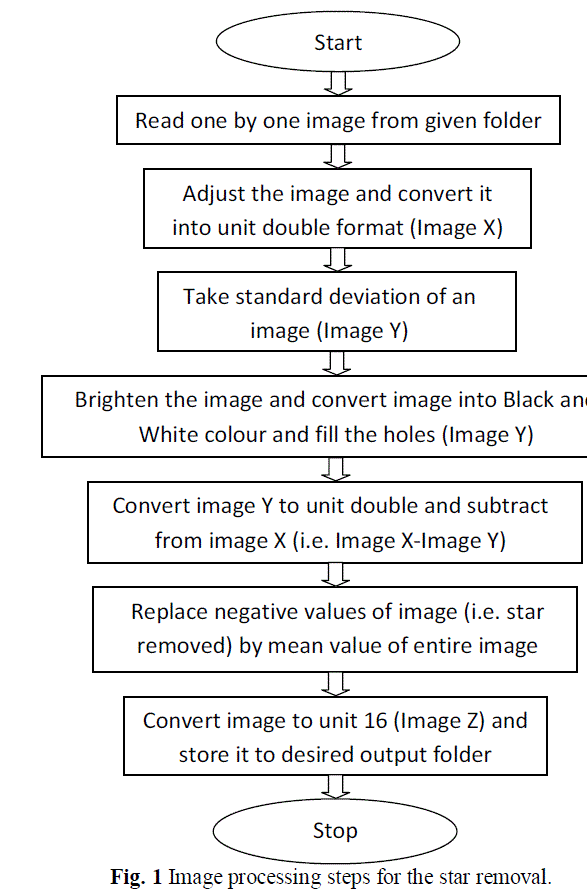 |
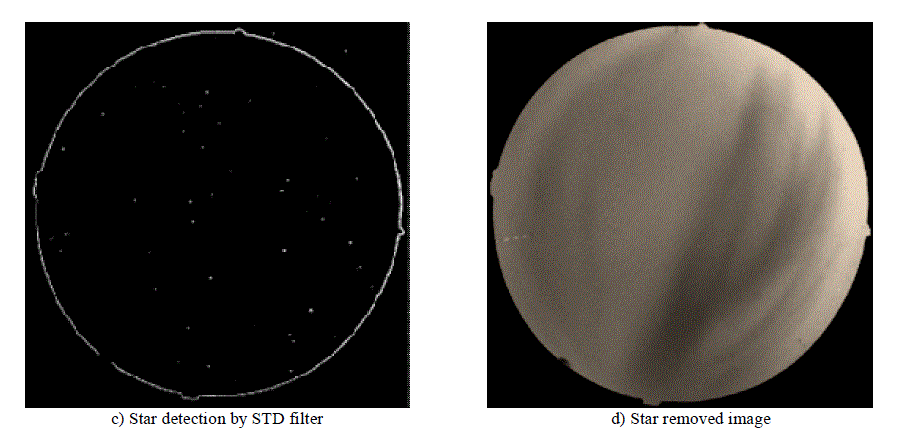 |
IV. COMPARISON TO OTHER METHODS |
A] Common filtering method in Mat Lab |
| The traditional filters like order, wiener and median etc. used in Mat Lab the high-frequency components of image may not be disturbed but filtering action produces blurring in the image which degrades the image information which is described in Fig. 3. |
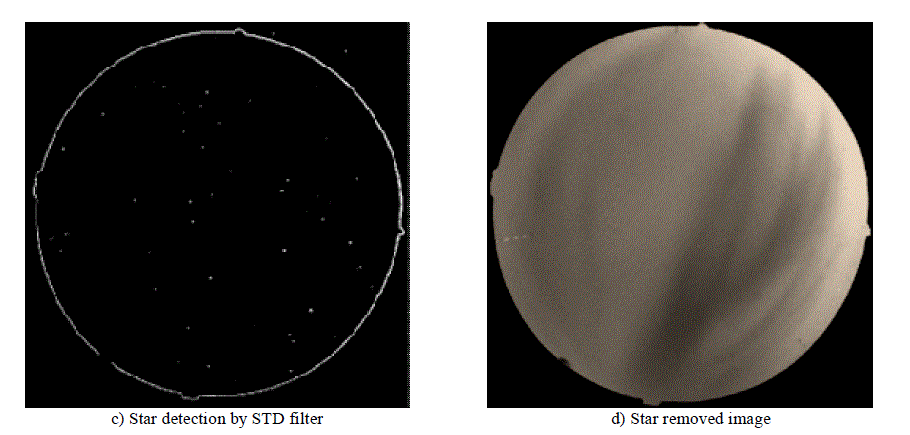 |
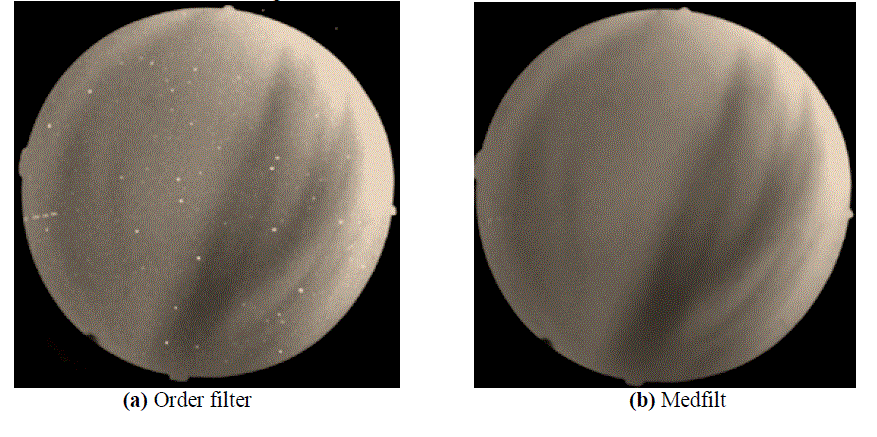 |
| In figure 3 (a) Order filter replaces each element in image by the orderth element in the sorted set of neighbours specified by the nonzero elements in domain but it does not remove stars and it blur the image. (b) Medfilt i.e. median filtering is a nonlinear operation often used in image processing to reduce "salt and pepper" noise it removes stars but it also blur the image. (c) In Filter-1 it filters the data in image with the two-dimensional FIR filter in the matrix h, this filtering method make the image almost white. (d) Wiener filter uses a pixel wise adaptive Wiener method based on statistics estimated from a local neighbourhood of each pixel. This filter also blurs the image. |
B] Threshold level |
| As we examine all images of ASI it is observed that stars has high intensity pixel values than other image pixel values so in threshold level method we can define some threshold value to detect high intensity pixels which are values nothing but stars and replace them by average intensity value of image or some other low intensity values. But in this method it cannot distinguish between the star and other sky high intensity values such as city light and other bright structures in the sky, so that it replace all values which is greater than the defined threshold value. It is difficult to define the common threshold to all images which causes error in star removal process. Simulation result of this technique is as shown Fig. 4. below. |
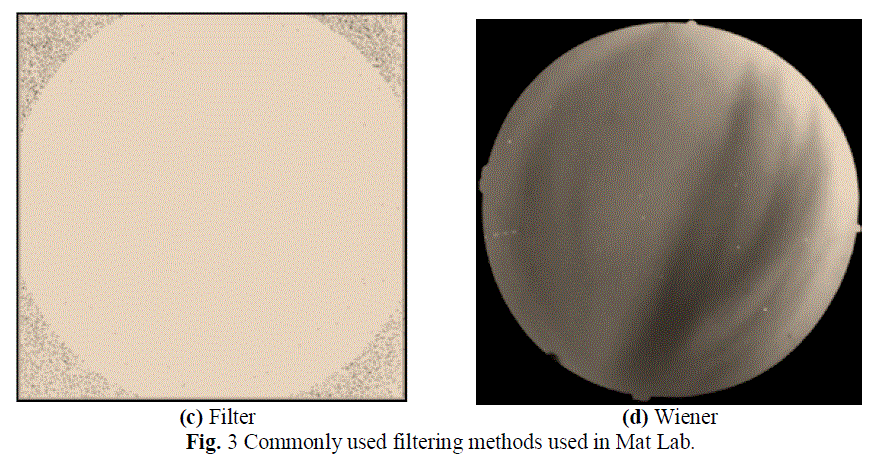 |
| As shown in image Fig.4 (b) the threshold level method removes the stars but it can also remove other structures as mentioned above which can disturb the image information, it can be easily observed in the image in which the right side light i.e. city light also considered as stars and its intensity is replaced by low intensity value making darker region. |
V. CONCLUSION |
| As per the required results, the proposed algorithm yields good filtering result using efficient noise (star) detection and removing mechanism. It can be much faster and convenient than other methods for filtering such type of noisy objects from images and these high-quality All-sky imager data can be used to investigate several key characteristics of the plasma depletions observed from low latitude ground based night airglow observing station. The developed algorithm can be effectively used to remove the stars in the galactic pictures to extract the correct information from them. |
References |
|